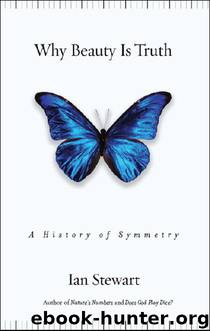Why Beauty is Truth by Ian Stewart

Author:Ian Stewart
Language: eng
Format: mobi, epub
ISBN: 9780465008759
Publisher: Basic Books
Published: 0101-01-01T00:00:00+00:00
If you’re thinking that this sounds a bit like attempts to solve the quintic, you’re onto something. If many capable mathematicians try something and fail, it is conceivable that it may be impossible. If there is one big thing mathematics has taught us, it is that many problems do not have solutions. You can’t find a fraction whose square is 2. You can’t trisect an angle with straightedge and compass. You can’t solve the quintic by radicals. Mathematics has limits. Maybe you can’t construct a three-dimensional algebra with all the nice properties you would like it to have.
If you’re serious about finding out whether that is indeed the case, a program of research opens up. First you need to specify the properties you want your three-dimensional algebra to have. Then you must analyze the consequences of those properties. Given enough information from that program, you can search for features that such an algebra must have if it does exist, and reasons why it might not exist.
At least, that’s what you would do today. Hamilton’s approach was not so systematic. He tacitly assumed that his algebra must have “all” reasonable properties, and suddenly realized that one of them might have to be dispensed with. More significantly, he realized that an algebra of three dimensions was not in the cards. The closest he could get was four. Quadruples, not triples.
Back to those elusive rules of algebra. When mathematicians do algebraic calculations, they rearrange symbols in systematic ways. Recall that the original Arabic name “al-jabr” means “restoration”—what nowadays we call “move the term to the other side of the equation and change its sign.” Only within the last 150 years have mathematicians bothered to make explicit lists of the rules behind such manipulations, deriving other well-known rules as logical consequences. This axiomatic approach does for algebra what Euclid did for geometry, and it took mathematicians only two thousand years to get the idea.
To set the scene, we can focus on three of these rules, all related to multiplication. (Addition is similar but more straightforward; multiplication is where everything starts to go pear-shaped.) Children learning their multiplication tables eventually notice some duplication of effort. Not only does three times four make twelve: so does four times three. If you multiply two numbers together you get the same result whichever one comes first. This fact is called the commutative law, and in symbols it tells us that ab = ba for any numbers a and b. This rule also holds in the extended system of complex numbers. You can prove this by examining Hamilton’s formulas for how to multiply pairs.
A subtler law is the associative law, which says that when you multiply three numbers together in the same order, it makes no difference where you start. For example, suppose I want to work out 2 × 3 × 5. I can start with 2 × 3, getting 6, and then multiply 6 by 5. Alternatively, I can start with 3 × 5, which is 15, and then multiply 2 by 15.
Download
This site does not store any files on its server. We only index and link to content provided by other sites. Please contact the content providers to delete copyright contents if any and email us, we'll remove relevant links or contents immediately.
| Applied | Geometry & Topology |
| History | Infinity |
| Mathematical Analysis | Matrices |
| Number Systems | Popular & Elementary |
| Pure Mathematics | Reference |
| Research | Study & Teaching |
| Transformations | Trigonometry |
Modelling of Convective Heat and Mass Transfer in Rotating Flows by Igor V. Shevchuk(6406)
Weapons of Math Destruction by Cathy O'Neil(6212)
Factfulness: Ten Reasons We're Wrong About the World – and Why Things Are Better Than You Think by Hans Rosling(4711)
A Mind For Numbers: How to Excel at Math and Science (Even If You Flunked Algebra) by Barbara Oakley(3251)
Descartes' Error by Antonio Damasio(3247)
Factfulness_Ten Reasons We're Wrong About the World_and Why Things Are Better Than You Think by Hans Rosling(3216)
TCP IP by Todd Lammle(3154)
Fooled by Randomness: The Hidden Role of Chance in Life and in the Markets by Nassim Nicholas Taleb(3079)
Applied Predictive Modeling by Max Kuhn & Kjell Johnson(3039)
The Tyranny of Metrics by Jerry Z. Muller(3026)
The Book of Numbers by Peter Bentley(2928)
The Great Unknown by Marcus du Sautoy(2661)
Once Upon an Algorithm by Martin Erwig(2620)
Easy Algebra Step-by-Step by Sandra Luna McCune(2603)
Lady Luck by Kristen Ashley(2552)
Police Exams Prep 2018-2019 by Kaplan Test Prep(2516)
Practical Guide To Principal Component Methods in R (Multivariate Analysis Book 2) by Alboukadel Kassambara(2512)
All Things Reconsidered by Bill Thompson III(2369)
Linear Time-Invariant Systems, Behaviors and Modules by Ulrich Oberst & Martin Scheicher & Ingrid Scheicher(2346)
